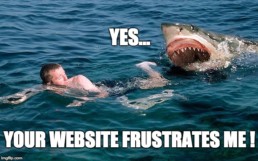Is Your Website Design Hurting You?
Is your website underperforming? Or worse, making you look like an amateur?
It could very well be your website design.
Fair or not, your prospects judge you by your website design.
The research is clear – potential customers are visiting your website and judging your business based on what they see.
75% of people judge the credibility of a company based on the design of its website
Stanford University
If your visitors like what they see, then they stay. Consume your content.
Engage and interact with your site.
And if you’ve planned out an effective sales funnel, they then become your new customers.
If they don’t like what they see – they quickly CLICK AWAY.
Gone forever. Off to your competition.
Ouch!
Of course, snap judgments aren’t breaking news. You and I do it everyday.
The fact is, we’re genetically hardwired to make split-second decisions.
So how much time does your website have… so potential customers dig deeper?
50 milliseconds (source).
Gulp.
Your website only has 0.05 seconds to make a good first impression.
Blame evolution for our ability to make judgements in the blink of an eye.
Great for when a big scary animal could eat us.
A different challenge when you’re trying to get potential customers to give you a shot at their business.

So how can you make the most of these 0.05 seconds? No pressure, right?
A good start, is by knowing how the brain creates shortcuts based on expectations.
Science calls these expectations “prototypical elements.”
In the case of your website, there are a number of prototypical elements your website visitors expect to see. Here are only a few:
- clear and intuitive navigation (the #1 design complaint about websites is difficult navigation)
- site copy that is easy-to-read and adds clarity to their overall experience
- a check-out in the top right corner (if you’re an ecommerce site)
- trust-building elements, like customer testimonials or reviews
When your website doesn’t conform to their expectations, it’s harder for your customer.
And harder is typically bad for sales.
When the worst happens, your potential customers will judge your website as either too confusing or poorly designed.
And leave.
Again, in the blink of an eye.
Beautiful design wins - and you get more customers

Like me, you probably noticed the red hat immediately. Your eyes might have been drawn to the arms, as they provide a kind of a frame for the hat…and if you took a deeper look, you may have followed the direction the woman is looking, with your eyes moving up her legs to her feet.
Then, to the contrast of the blue water, slightly lapping against the woman’s legs. Then, to the darker blue in the shape of a person’s shadow (presumably a man) looking toward the woman.
Clarity of focus and simplicity are prized design elements. And for good reason. Effective visual design can create a story worthy of your brand.
A compelling emotional connection.
A connection that the research supports. According to this Google study, website visitors consistently rated visually simple websites as more beautiful.
And the opposite is true – when the visual complexity of your website is high, your potential customers perceive it as less beautiful.
SIMPLE = BEAUTIFUL.
Even with layouts that had a high level of familiarity, simplicity and beauty won the day.
And beauty converts better.
As Steve Jobs famously said:
Simple can be harder than complex: You have to work hard to get your thinking clean to make it simple. But it’s worth it in the end because once you get there, you can move mountains.
Today more than ever, companies rely on their website to communicate who they are to their potential customers.
To develop that important emotional connection.
Don’t forget, your website is often the first face your customers will see. The first point of contact.
If that’s not to your benefit, it’s critical you change that.
The good news, is that research-based and field-tested web design practices allow you to make a strong first impression. And those same practices allow you to shape the customer journey.
To lead your potential customer down the path to increased conversions.
And that means more paying customers.
It’s part art, and a whole lot of science.
The science and psychology of effective web design

The research and science of website design has become more and more sophisticated. And it’s impact on consumer purchasing behavior can now be measured.
And that makes it a valuable tool in your marketing.
So, in a world where today’s consumer has almost limitless options…all within the click of a mouse, where’s a good place to start?
Not surprisingly, attention is one of “the” critical elements to success.
When visitors come to your website, grab and keep their attention.
The emotional brain (which has a huge impact on our decisions) is affected by pictures. So use them to your advantage.
Especially pictures of people.
Used correctly, they are one of many tools that can help your visitors focus. And focus reduces friction.
That helps buyers buy from you.
As Victoria Young puts it:
Today, the most successful digital experiences have emerged out of focusing on reducing friction in the user journey.
And what exactly is friction at your website?
Anything that makes life too difficult for your visitor.
In user experience, friction is defined as “interactions that inhibit people from intuitively and painlessly achieving their goals.”
Friction is normally bad because it reduces conversions, and frustrates potential customers to the point of abandoning their tasks.
In other words, don’t make your website visitor work too hard.
Visitors will do the least amount of work possible to get a task done – like buy your product.
An example of page scanning patterns
Well known eye-tracking studies like this and this show us how users view website content and how visual relationships affect their focus on the page.
With attention at a premium, it’s critical that every element on a page adds value to your visitor.
Of course, a large number of elements influence the visual design of your site. Here are only a few:
- font selection
- white space
- contrast
- size
- color
When we utilize any of these elements in purposeful ways, we need to consider how they impact our visitor.
And we need to remember that web surfers skim.
We hunt and peck.
Seeking out information that’s relevant.
And most of the time…disregarding information that isn’t.
When we work within this framework, we can create page design patterns that work for your customers.
And ultimately, help your business grow.
Designing your website for your users requires testing

Making informed choices and improving visual design—including layout, color, graphics, and text choice – is a process.
When done well, your website becomes your top salesperson.
Generating leads.
And revenue.
24 hours a day, seven days a week.
It’s begins with a clear understanding of design principles and human psychology, in the context of clearly defined business goals.
It is refined through testing.
And more testing.
And still more testing.As user experience expert Jeff Horvath says here:
A good user experience, like a measurable ROI, doesn’t typically happen by accident. It takes careful planning, analysis, investment, and continuous improvement.
Conclusion
Bad design can be frustrating and inconvenient. And it can hurt your business.
Because your visitors determine the success of your website, they should be the focus of your research and design.
Naturally, understanding the principles of design is critical. And knowing what rules can be broken and how they can be applied effectively takes context that comes with experience.
But make no mistake, testing is a key part of the web design process.
Effective design – and one that improves your bottom line – is about researching what makes your buyers buy from you. And then delivering that message in a visually beautiful and engaging way.
